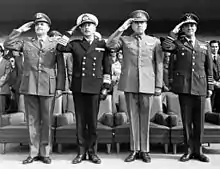Government Junta of Chile (1973)
The Government Junta of Chile (Spanish: Junta Militar de Gobierno) was the military junta established to rule Chile during the military dictatorship that followed the overthrow of President Salvador Allende in the 1973 Chilean coup d'état. It was the executive and legislative branch of government until December 17, 1974. After that date, it functioned strictly as a legislative body until the return to democracy in 1990.
Creation

On September 11, 1973, the day of the coup, the military officers issued an Act of Constitution. The act established a junta government that immediately suspended the constitution, suspended Congress, imposed strict censorship and curfew, proscribed the leftist parties that had constituted Salvador Allende's Popular Unity coalition, and halted all political activity, effectively establishing a dictatorship. The judicial branch continued to operate under the Junta, and nominally had jurisdiction over its repressive activities, but rarely interfered.
The new junta was made up of General Gustavo Leigh representing the Air Force, General Augusto Pinochet representing the Army, Admiral José Toribio Merino representing the Navy, and General César Mendoza representing the Carabineros (uniformed Gendarmerie).
Members
| Representing | Name | Took Office | Left Office |
|---|---|---|---|
| Army | Augusto Pinochet | September 11, 1973 | March 11, 1981 |
| César Benavides | March 11, 1981 | December 2, 1985 | |
| Julio Canessa | December 2, 1985 | December 31, 1986 | |
| Humberto Gordon | December 31, 1986 | November 29, 1988 | |
| Santiago Sinclair | November 29, 1988 | January 2, 1990 | |
| Jorge Lucar | January 2, 1990 | March 11, 1990 | |
| Navy | José Toribio Merino | September 11, 1973 | March 8, 1990 |
| Jorge Martínez Busch | March 8, 1990 | March 11, 1990 | |
| Air Force | Gustavo Leigh | September 11, 1973 | July 24, 1978 |
| Fernando Matthei | July 24, 1978 | March 11, 1990 | |
| Carabineros | César Mendoza | September 11, 1973 | August 2, 1985 |
| Rodolfo Stange | August 2, 1985 | March 11, 1990 | |
Chiefs
| Representing | Name | Took Office | Left Office |
|---|---|---|---|
| Army | Augusto Pinochet | September 11, 1973 | March 11, 1981 |
| Navy | José Toribio Merino | March 11, 1981 | March 8, 1990 |
| Jorge Martínez Busch | March 8, 1990 | March 11, 1990 | |
History


Once the Junta was in power, General Pinochet soon consolidated his control. Since he was the commander-in-chief of the oldest branch of the military forces (the Army), he was made the head of the military junta. This position was originally to be rotated among the four branches, but was later made permanent. He began by retaining sole chairmanship of the junta as Supreme Chief of the Nation from June 27, 1974 until December 17, 1974 when he was proclaimed President.
General Pinochet took over as President, following a referendum that approved a new constitution. On March 11, 1981, he resigned his position in the Junta, and was replaced by the most senior General officer from the Army, who was nominated by himself. After that date, the Junta remained only as a legislative body under the presidency of Admiral Merino, until the return to democracy in 1990.
Eventually, General Leigh, head of the Air Force, became increasingly opposed to Pinochet's policies and was forced into retirement on July 24, 1978, in a very tense moment that almost caused a military insurrection. He was replaced by General Fernando Matthei.
In 1985, three communists were found with their throats slit by the side of a road. The guilty party turned out to be the Carabineros' secret service, and the Caso Degollados ("case of the slit throats") caused General Mendoza's resignation on August 2, 1985, being replaced by General Rodolfo Stange.
Human rights record
Immediately after the coup the junta moved to crush their left-wing opposition. In addition to pursuing armed revolutionary groups it embarked on a campaign against opponents and perceived leftists in the country. As a result, according to the Rettig Commission, approximately 3,000 people are known to have been killed, 27,000[1] were incarcerated and in a great many cases tortured. Many were exiled and received abroad, in particular in Argentina, as political refugees; however, they were followed in their exile by the DINA secret police, in the frame of Operation Condor which linked South-American dictatorships together against political opponents.
See also
Notes
- most of them for long periods of time, without trials and in special secluded facilities in remote locations. There are many cases of torture. Some leftist human rights organizations say more than 200,000 were arrested and tortured but there is no evidence to support that number. The Valech Report (published in November 2004) tells of some 28,000 arrests in which the majority of those detained were tortured.
